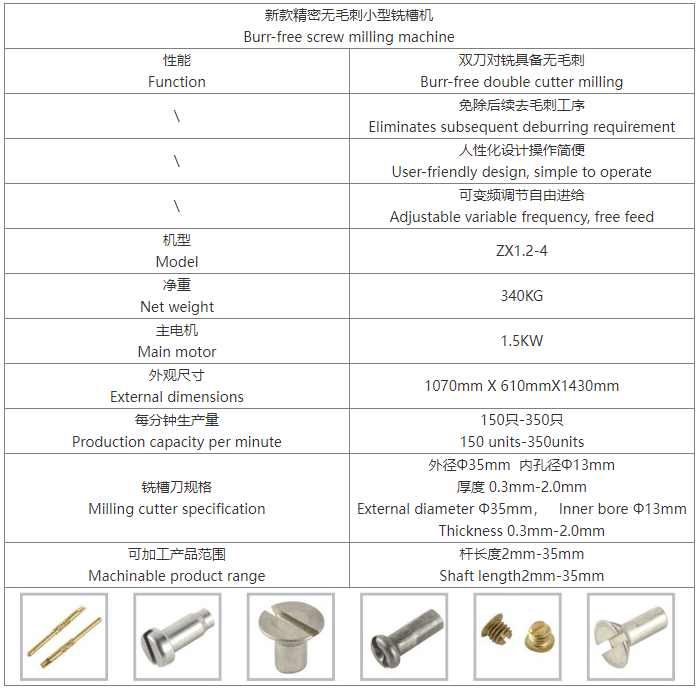In the field of precision manufacturing, the machining accuracy and surface quality of small parts are the key to production. Our precision burr free small groove milling machine is designed specifically to meet this demand, capable of achieving high-precision, burr free groove milling, while also having automated operation and wide applicability.
Precision burr free small groove milling machine is a high-precision equipment specifically designed for milling grooves on small workpieces and achieving burr free machining. The following is its introduction:
Equipment features
High precision machining: Advanced technologies such as high-precision linear guides and high-precision grinding ball screws are used, with machining accuracy of ± 0.02mm or even higher, which can meet the needs of precision machining.
• Non burr design: By using special tool design, processing techniques, or adding deburring devices, the effect of no burrs after milling grooves can be achieved, eliminating subsequent deburring processes and improving production efficiency and product quality.
High degree of automation: equipped with automatic feeding system, automatic loading and unloading device, and PLC programming control, it can achieve automated processing, reduce manual operation, improve production efficiency and processing consistency.
Wide applicability: Suitable for small workpieces made of various materials, such as copper, aluminum, iron, stainless steel and other metal materials, as well as some non-metallic materials. It can process various groove types such as D-shaped surface, parallel surface, groove, parallel groove, straight groove, cross groove, etc.
Compact structure: Small in size, occupying a small area, easy to install and operate, suitable for use in workshops or production lines with limited space.
Strong durability: Using high-quality materials and advanced manufacturing processes, it has a long service life and stable performance.
Working principle
• Tool cutting: Cutting the workpiece with specific milling cutters (such as vertical milling cutters, circular saw blades, etc.) to form the desired groove. During the cutting process, adjust parameters such as tool speed, feed rate, and cutting depth according to different materials and processing requirements.
Power drive: Generally, electric motors or hydraulic systems are used as power sources to drive the rotation of milling cutters and the feed motion of workpieces, achieving milling groove machining.
Control method: PLC programming control or CNC system is used to achieve automatic control of the milling machine by inputting machining programs and parameters, including tool motion trajectory, speed, machining sequence, etc.
application area
Hardware processing: used for processing various small hardware parts, such as screws, screws, shaft core parts, etc., to meet their machining needs such as milling grooves and flattening.
Electronics industry: can be used for the processing of electronic components, such as milling grooves on small electronic components such as circuit boards and connectors, to achieve their functions or connection requirements.
Instrument industry: Processing small parts in precision instruments to ensure their dimensional accuracy and surface quality, meeting high-precision requirements.
Glasses industry: Processing grooves for small components such as eyeglass frames to ensure their accuracy and appearance quality.
In other fields such as medical equipment and toy manufacturing, milling grooves are performed on small workpieces to meet product design and functional requirements.
advantage
• Improve production efficiency: Automated processing reduces manual operation time and labor intensity, while burr free processing avoids subsequent deburring processes and shortens production cycles.
• Improving product quality: High precision machining and burr free effect have improved the dimensional accuracy, surface quality, and appearance quality of the product, enhancing its market competitiveness.
• Cost reduction: The high degree of automation of the equipment can reduce labor costs; At the same time, high processing accuracy and good product quality reduce the scrap rate, improve material utilization, and thus reduce production costs.
• Easy and convenient operation: Equipped with an advanced control system, the interface is user-friendly, easy to program and operate, and can be easily mastered through simple training, reducing the technical requirements for operators.
Key selection points
Processing requirements: Select the appropriate milling machine model and specifications based on the material, size, shape, required groove type, and precision requirements of the workpiece.
• Automation level: Based on production scale and automation requirements, select milling machines with corresponding automation functions, such as automatic feeding, automatic loading and unloading, automatic tool changing, etc.
Equipment performance: Pay attention to performance indicators such as machining accuracy, repeat positioning accuracy, spindle speed, and tool speed range of the equipment to meet the requirements of high-precision machining.
Brand and after-sales service: Choosing products from well-known brands ensures better quality and performance. At the same time, good after-sales service can promptly solve problems that arise during equipment use, ensuring the normal operation of the equipment.

Contact: Sam
Phone: +86 186 8899 7860
E-mail: info@boosum.com
Add: No. 109, Houting Second Industrial Zone, Shajing Street, Bao'an District, Shenzhen